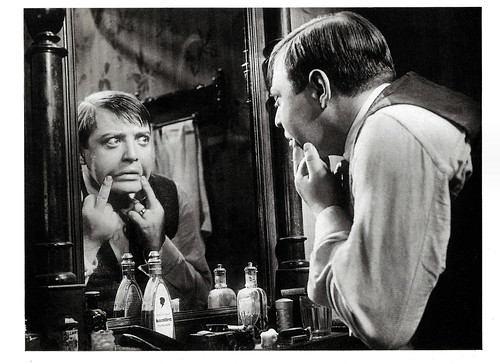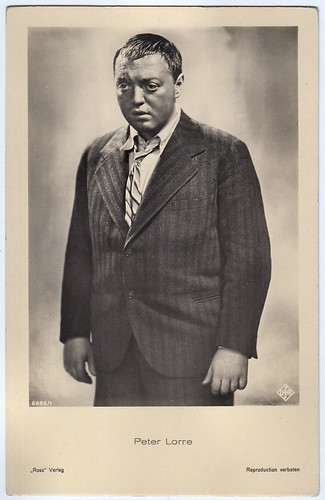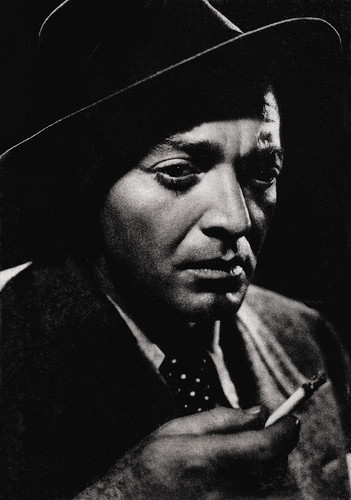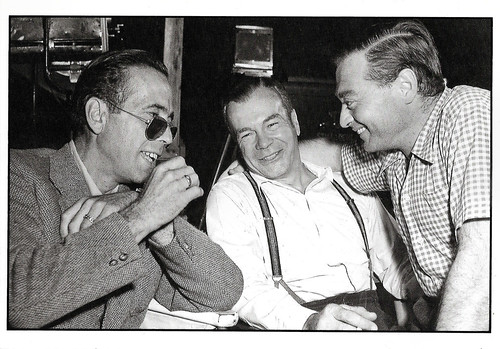His voice summons angels and demons, his body and face are those of a child heavy with guilt. All in all, Lorre’s life, his films, his unrealised dreams, and his physical presence constitute one of the most honest representations of 20th-century man, writes Horwath at the festival site. 'Instead of wholeness and triumph, there is the half-full, half-empty result of traversing through Central European modernism and fascism, addiction and exile, the culture of money and fame, the mirror cabinet of faces and masks.

Swiss-British-German postcard by News Productions, Baulmes and Stroud, Filmwelt Berlin, Bakede, no. 56537. Photo: Collection Cinémathèque Suisse / Nero Film. Peter Lorre in M – Eine Stadt sucht einen Mörder/M (Fritz Lang, 1931).

Dutch postcard, no. 850. Photo: Warner Bros.
Bertold Brecht
Peter Lorre was born László Löwenstein in 1904 in the Austro-Hungarian town of Ružomberok in Slovakia, then known by its Hungarian name Rózsahegy. He was the first child of Jewish couple Alajos Löwenstein and Elvira Freischberger. His father was the chief bookkeeper at a local textile mill. Besides working as a bookkeeper, Alajos Löwenstein also served as a lieutenant in the Austrian army reserve, which meant that he was often away on military manoeuvres.
When Lorre was four years old, his mother died, probably of food poisoning, leaving Alajos with three very young sons, the youngest only a couple of months old. He soon remarried, his wife's best friend, Melanie Klein, with whom he had two more children. However, Lorre and his stepmother never got along, and this coloured his childhood memories.
At the outbreak of the Second Balkan War in 1913, Alajos moved the family to Vienna, anticipating that this would lead to a larger conflict and that he would be called up. He was right. In 1914, the outbreak of World War I followed. He served on the Eastern front during the winter of 1914-1915, before being put in charge of a prison camp due to heart trouble.
As a youth, Peter Lorre ran away from home, worked as a bank clerk, and after stage training in Vienna, made his acting debut in Zurich in Switzerland at the age of 17. In Vienna, he worked with the Viennese Art Nouveau artist and puppeteer Richard Teschner. He then moved to the then German town of Breslau, and later to Zürich.
In the late 1920s, Peter Lorre moved to Berlin, where the young and short (165 cm) actor worked with German playwright Bertolt Brecht. He made his film debut in a bit role in the Austrian silent film Die verschwundene Frau/The vanished woman (Karl Leitner, 1929), followed by another small part in the German drama Der weiße Teufel/The White Devil (Alexandre Volkoff, 1930) starring Ivan Mozzhukhin.
On stage and in the cinema, Lorre played a role in Brecht's Mann ist Mann/A Man's a Man (Bertolt Brecht, Carl Koch, 1930) and as Dr. Nakamura in the stage musical 'Happy End' (music by composer Kurt Weill), alongside Brecht's wife Helene Weigel, Oskar Homolka and Kurt Gerron.

German postcard by Ross Verlag, no. 6989/1, 1931-1932. Photo: Ufa. Publicity still for Schuß im Morgengrauen/A Shot at Dawn (Alfred Zeisler, 1932). Collection: Marlene Pilaete.

German collectors card by Ross Verlag for Jasmatzi Cigarettenfabrik G.m.b.H., Dresden, in the series 'Hänsom Filmbilder, Serie V, Bild no. 84 (1-147). Photo: Ufa. Ery Bos and Peter Lorre in Schuss im Morgengrauen/A Shot at Dawn (Alfred Zeisler, 1932).
Fritz Lang
Peter Lorre became much better known after director Fritz Lang cast him in the lead role of Hans Beckert, the mentally ill child murderer in the classic thriller M (1931).
Later, the Nazi propaganda film Der ewige Jude/The Eternal Jew (Fritz Hippler, 1940) used an excerpt from the climactic scene in M in which Lorre is trapped by vengeful citizens. His passionate plea that his compulsion is uncontrollable, says the voice-over, makes him sympathetic and is an example of attempts by Jewish artists to corrupt public morals.
M was Lang’s first sound film and he revealed the expressive possibilities of combining sound and visuals. Lorre's character whistles the tune 'In the Hall of the Mountain King' from Edvard Grieg's 'Peer Gynt Suite No. 1'. Lorre himself could not whistle – it is actually Fritz Lang who is heard.
The film was one of the first to use a leitmotif, associating 'In the Hall of the Mountain King' with the Lorre character. Later in the film, the mere sound of the song lets the audience know that he is nearby, off-screen. This association of a musical theme with a particular character or situation, a technique borrowed from opera, is now a film staple.
Lorre’s next role was the German musical comedy Bomben auf Monte Carlo/Monte Carlo Madness (Hanns Schwarz, 1931) starring Hans Albers and Anna Sten. That year he also co-starred in the comedy Die Koffer des Herrn O.F./The Trunks of Mr. O.F. (Alexis Granowsky, 1931) starring Alfred Abel, and Harald Paulsen.
In 1932 Lorre appeared again alongside Hans Albers in the drama Der weiße Dämon/The White Demon (Kurt Gerron, 1932) and the Science Fiction film F.P.1 antwortet nicht/F.P.1 Doesn't Respond (Karl Hartl, 1932) about an air station in the middle of the Atlantic Ocean. Curt Siodmak had written the story after Charles Lindbergh's transatlantic flight. It was the last German film that either Siodmak or Lorre, who played a secondary character, would make in Germany before the war.

British postcard in the Picturegoer Series, London, no. 1033A. Photo: 20th Century Fox.
Alfred Hitchcock
When the Nazis came to power in Germany in 1933, Peter Lorre took refuge in Paris, where he appeared with Jean Gabin and Michel Simon in the charming comedy Du haut en bas/High and Low (Georg Wilhelm Pabst, 1933).
Then Lorre moved on to London. There Ivor Montagu, Alfred Hitchcock's associate producer for The Man Who Knew Too Much (1934), reminded the director about Lorre's performance in M. They first considered him to play the assassin in the film, but they wanted to use him in a larger role, despite his limited command of English at the time, which Lorre overcame by learning much of his part phonetically.
The Man Who Knew Too Much was one of the most successful and critically acclaimed films of Hitchcock's British period. Lorre also was featured in Hitchcock's Secret Agent (Alfred Hitchcock, 1936), opposite John Gielgud and Madeleine Carroll.
Lorre settled in Hollywood in 1935, where he specialised in playing sinister foreigners, beginning as the love-obsessed surgeon in the horror film Mad Love (Karl Freund, 1935), and as Raskolnikov in the Fyodor Dostoevsky adaptation Crime and Punishment (Josef von Sternberg, 1936).
He starred in a series of eight Mr. Moto movies for Twentieth Century Fox, a parallel to the better-known Charlie Chan series. Lorre played the ever-polite (albeit well versed in karate) Japanese detective Mr. Moto. According to Wikipedia, he did not enjoy these films — and twisted his shoulder during a stunt in Mr. Moto Takes a Vacation (Norman Foster, 1939) — but they were lucrative for the studio.
When the series folded in 1939, Lorre free-lanced in villainous roles at several studios. In 1940, he co-starred with fellow horror actors Bela Lugosi and Boris Karloff in the comedy You'll Find Out (David Butler, 1940), a vehicle for bandleader and radio personality Kay Kyser.

British postcard in the Picturegoer Series, London, no. 1033A. Photo: 20th Century Fox.

Postcard (ca. 1970s).
Sydney Greenstreet
In 1941, Peter Lorre became a naturalised citizen of the United States. He enjoyed considerable popularity as a featured player in Warner Bros. suspense and adventure films. Lorre played the role of effeminate thief Joel Cairo opposite Humphrey Bogart in The Maltese Falcon (John Huston, 1941), a classic Film Noir based on the novel of the same name by Dashiell Hammett.
The Maltese Falcon was Huston's directorial debut and the film was nominated for three Academy Awards. Then Lorre portrayed the character Ugarte in Casablanca (Michael Curtiz, 1942).
One of his co-stars in both films was Sydney Greenstreet with whom he made 9 films. Most of them were variations on Casablanca, including Background to Danger (Raoul Walsh, 1943), with George Raft, Passage to Marseille (Michael Curtiz, 1944), reuniting them with Humphrey Bogart and Claude Rains, and Three Strangers (Jean Negulesco, 1946).
Three Strangers was a suspense film about three people who are joint partners on a winning lottery ticket starring top-billed Greenstreet, Geraldine Fitzgerald, and third-billed Lorre cast against type by the director as the romantic lead.
Hal Erickson at AllMovie: “As far as director Jean Negulesco was concerned, Lorre was the finest actor in Hollywood; Negulesco fought bitterly with the studio brass for permission to cast Lorre as the sympathetic leading man in The Mask of Dimitrios (1946), in which the diminutive actor gave one of his finest and subtlest performances.”
Greenstreet and Lorre's final film together was the suspense thriller The Verdict (1946), director Don Siegel's first film. Lorre branched out into comedy with the role of Dr. Einstein in Frank Capra's version of Arsenic and Old Lace (1944), starring Cary Grant and Raymond Massey.

French postcard in the Entr'acte series by Éditions Asphodèle. Mâcon, no. 001/14. Humphrey Bogart, Gordon Carveth, and Peter Lorre at the set of Confidential Agent (Herman Shumlin, 1945). Caption: Humphrey Bogart and Gordon Carveth visit their friend Peter Lorre on the set of Confidential Agent; Lorre is the star.
Trailer M (1931). Source: HD Retro Trailers (YouTube).
James Bond Villain
After World War II, Peter Lorre's acting career in Hollywood experienced a downturn, whereupon he concentrated on radio and stage work. An exception was the horror classic The Beast with Five Fingers (Robert Florey, 1946).
In Germany, Lorre co-wrote, directed, and starred in Der Verlorene/The Lost One (1951), an art film in the Film Noir idiom. Hal Erickson: “In keeping with Lorre's established screen persona, this is a tale of stark terror, disillusionment, and defeatism. The actor stars as Dr. Rothe, a German research scientist who during WW2 discovers that his fiancée has been selling his scientific secrets to the British. In a fit of pique, he murders her but is not punished for the crime, which is passed off by the Nazi authorities as justifiable homicide. (...) Not entirely successful, Der Verlorene is still a fascinating exercise in fatalism from one of the cinema's most distinctive talents.”
Lorre then returned to the United States where he appeared as a character actor in television and feature films, often parodying his 'creepy' image. In 1954, he was the first actor to play a James Bond villain when he portrayed Le Chiffre in a television adaptation of Casino Royale, opposite Barry Nelson as an American James Bond and Linda Christian as the first Bond girl.
Lorre starred alongside Kirk Douglas and James Mason in 20,000 Leagues under the Sea (Richard Fleischer, 1954), and appeared in a supporting role in Voyage to the Bottom of the Sea (Irwin Allen, 1961). He worked with Roger Corman on several low-budget films, including two films of the director's Edgar Allan Poe cycle, Tales of Terror (1962) and The Raven (1963).
Peter Lorre was married three times: actress Celia Lovsky (1934–1945); actress Kaaren Verne (1945–1950) and Anne Marie Brenning (1953-1964, his death). In 1953, Brenning bore his only child, Catharine. In later life, Catharine made headlines after serial killer Kenneth Bianchi confessed to police investigators after his arrest that he and his cousin and fellow Hillside Strangler Angelo Buono, disguised as police officers, had stopped her in 1977 with the intent of abducting and murdering her. They let her go upon learning that she was the daughter of Peter Lorre. It was only after Bianchi was arrested that Catharine realised whom she had met. Catharine died in 1985 of complications arising from diabetes.
Lorre had suffered for years from chronic gallbladder troubles, for which doctors had prescribed morphine. Lorre became trapped between the constant pain and addiction to morphine to ease the problem. It was during the period of the Mr. Moto films that Lorre struggled and overcame his addiction. Abruptly gaining a hundred pounds in a very short period and never fully recovering from his addiction to morphine, Lorre suffered many personal and career disappointments in his later years.
His final film was the Jerry Lewis comedy The Patsy (Jerry Lewis, 1964) in which, ironically, the dourly demonic Lorre played a director of comedy films. A few months after completing this film, Peter Lorre died of a stroke in 1964 in Los Angeles. He was 59.
Trailer The Man Who Knew Too Much (1934). Source: Jeff Sabu (YouTube).
Der Verlorene/The Lost One (1951). Source: chpthncook37 (YouTube).
Sources: Hal Erickson (AllMovie), Ed Stephan (IMDb), Wikipedia, and IMDb.
No comments:
Post a Comment